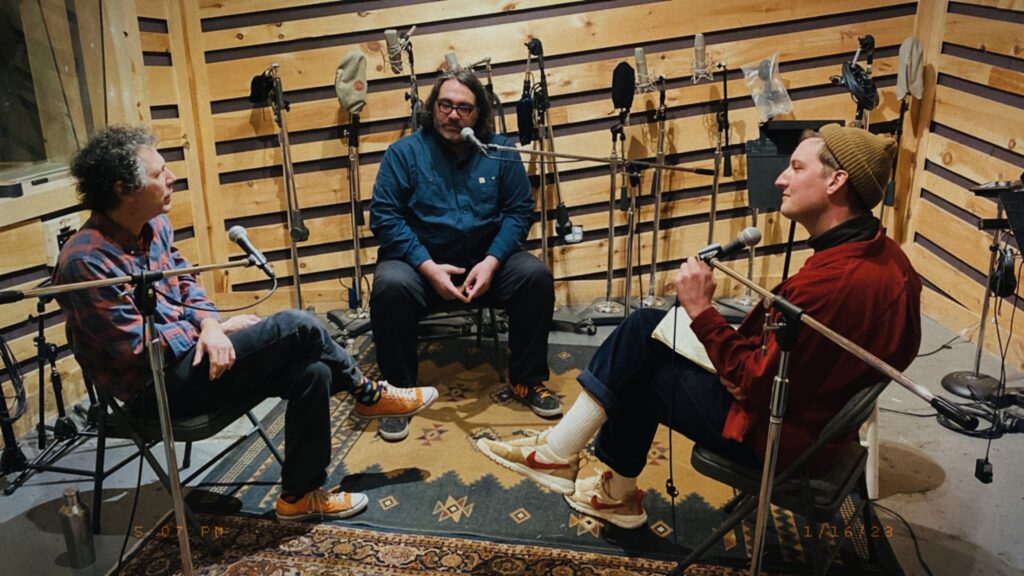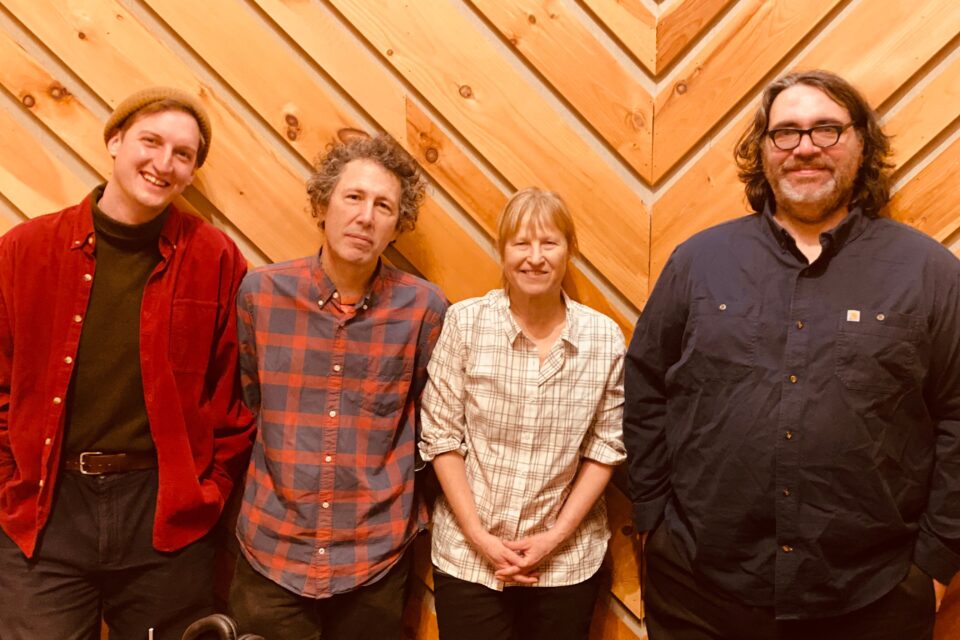In January I flew out to New York City to record a few songs and interview Yo La Tengo about their new album “This Stupid World” which is available now.
Yo La Tengo has been a band for 38 years. For the past thirty years they have been a trio, consisting of Ira Kaplan, Georgia Hubley and James McNew.
There is no lead singer in Yo La Tengo. There is no singular guitarist, drummer or bass player. Their willingness to experiment with structure and sound has resulted in a listening experience that feels like a constant state of exploration. “This Stupid World” is a triumph. Their first self produced full studio album and one of their best.
Here they talk about making decisions as a band, finding their voice, and what has changed, or not changed, in Yo La Tengo.
So, “This Stupid World” is the title. You have a title track. What is the sentiment of the song and title?
Ira: It’s whatever you make of it.
We do it and others interpret it.
What was the moment that sparked that? What were you doing?
Ira: I was trying to write lyrics. I was staring at a computer screen and that just came out. And then it was pretty easy to focus on.
As you noted, it’s the title track and we’ve never done that before.
All of our songs are finished before the words have begun. So this was no exception. It was just kind of looking for lyrics.
For a song like, “This Stupid Word” I will often think, “Is this improvised?” Or is it all structured out and it just sounds kind of free?
Ira: It depends on the song. Some of the things are pretty free, but others get refined to get to that point.
James: And you don’t know who is playing what, which is something that we always enjoy quite a bit. It’s a great deal of fun to play someone else’s instrument and to not play the instrument you usually play. It’s a great feeling and a great sound. When Georgia plays guitar it sounds different than anyone else. And when I throw a stick at a drum it sounds much different than when Georgia plays it.
There is a lot of freedom in all of the tracks that we recorded for this record.
A lot of it had no destination really in mind. We were just enjoying doing it. And it’s the sound of us enjoying doing something.
For the songs that end up as some of the longer ones, walk me though the process of when you are in there and when you have figured it out.
Ira: A number of songs on this record originate with jams and then they get edited.
James: We record ourselves a lot when we are jamming so we can go back and listen to things.
I remember that we went back and investigated a jam that we had been doing and we tried to do it again and it was like, “No this isn’t working.” Then the guitar part changed and it was like, “No that’s not working either.: And the bass part changed and that wasn’t working. Then the drums changed and it was like, “Oh that’s something.” And that became “Fallout.” So it’s like the original article except that we’re replaced every single piece.
You can never step in the same river twice.
James: Precisely.
This is a self produced album. What jobs did you do that a producer would normally do?
Ira: It has felt like a very natural progression and also not a particularly planned one either. It’s not like we sat down and said, “Let’s do this.”
When we worked with John McEntire on “Fade” (2013) we went there with some pretty evolved tracks that James had recorded in Hoboken. Then we went there and rerecorded a lot of what we did, but also used a lot of that stuff. So when we started working on what became “There’s a Riot Going On” (2018) we were kind of proceeding the same way. We were making all these recordings that James was doing and at a certain point we thought, “Well, maybe we don’t have to go to a studio to record them.” We were happy with what we got. And instead we went to John and mixed with him.
One of the big differences between John and Rodger Moutenot who had produced so many records before that was that Roger was much more interested in expressing his opinion than John, so when we would disagree about something, with Roger, three heads would turn to Roger to see what he thought. And when we would look at John, we would be like, “I’m right here when you decide.” I didn’t think we were ever terrible at making decisions as a group, but we improved at it to such an extent that the role of producer as arbiter or outside voice it just seemed, as we were working on “This Stupid World” that we were doing fine without it.
We just kind of looked at each other and thought, maybe we don’t need to go anywhere else. We’re fine.
I would think that it would be hard to make a decision in such an egalitarian band. That it would be nice to have a person to turn your head to.
Ira: You would think that.
James: I could see how you would think that.
How do you make those decisions?
Ira: One thing that I don’t think we have ever been is like, you read about The Beatles and John Lennon and Paul McCartney were in such competition. That kind of drove them. Each trying to out do the other one. You hear that a lot. That without dissension you’re not pushing yourself hard enough. Without a question I bought into that years ago. That if we are too comfortable it means something is going wrong. None of us believe that anymore.
We have much greater belief in three of us than in any one of us singly.
A huge part of that was how aggressively James poured himself into learning more and more about the recording process. Every day he would come in and say, “This is how they did it on this Beatle record. I’m gonna try this.” Or, “These Motown-y cues do this.” So rather than being afraid of that and thinking we needed an expert, like, none of us are experts on our instruments, why do we need an expert doing anything else? It seems to have worked out.
James: I just remembered that I was in touch with Jad Fair of Half Japanese and I had recently listened to their first record, “1/2 Gentlemen/Not Beasts” and I was like, “John, we are all marooned at home. Can I ask you some questions?” So I just started asking him like, “How in the world did you make this?” My imagination ran wild. But they were just two brothers in their living room, or actually in their basement, as it turns out, figuring out how to record themselves with like one microphone. Getting Jad to walk back through the technical angles of making that was so incredibly inspiring. After that it was like, “We are doing this!” They made this absolutely amazing record with not a care in the world.
To be 40 years into this band and still be learning new things…
James: It feels good to be old and learning things. That’s sweet. I totally recommend it.
Another thing that felt like a revelation was that, in making records and the technical side of things I realized that these guys were all scientists. They all wore lab coats and carrying clipboards. They had degrees to plug in these microphones and learn how the do the circuitry and everything. And that carried on. When we were in the studio making records, Roger and John, they are wizards. They are scientists and wizards at the same time. I didn’t know what they were doing. They are both very sweet people but it is very intimidating. The studio environment can be a very intimidating experience. Especially when you do it for a long time. It’s a long and intimidating experience. To demystify some of that stuff was very liberating.
What was a trick that you learned that you applied?
James: Oh gosh. If you want to do another interview we can talk about the phase analyzer because phase analysis is pretty impressive. You see we have eight mics going at the same time and they are all different distances from the sound sources and when you align the phase the sound changes quite a bit. Usually for the better.
Ira: But not always. That’s kind of the cool thing. The wrong way sounds better to us than the right way.
Let’s go on to “Aselestine.” What is aselestine? I do not know that word.
Ira: Yeah, do I feel like answering that question? I’m not sure. We’re aware that the song raises that question. But a little bit of mystery is not a bad thing.
You often sing in a tone that is much gentler than most singers. How did you figure out that hushed tone?
Ira: To sing as quietly as Georgia and I do, it’s a tremendous challenge to the person doing the recording. It’s a great challenge to Mark who does our front of house, and Dutch who mixes the monitors. But they’ve all been so supportive about being able to do it. Again, it’s an example of doing something that, by a lot of definitions is just wrong.
I can remember specific steps in getting to that point. “Our Way to Fall” was one that really jumps out.
We recorded it in Nashville. And we were mixing it in New York, and I remember just being so unhappy with the way it sounded. And Roger had this little weird microphone. I just sat in the control room, singing, probably without even headphones on, which again, is something you’re not supposed to do, and just singing it in this completely other way. And thinking, “Well that was wrong, but that feels right.” And I know that lead to more of that.
Collaboration is definitely a part of Yo La Tengo. You just had the Hanukkah concerts. How did the Hanukkah concerts come to be?
Ira: It was a joke we wouldn’t stop telling.
Every once in a while we would think about having some kind of like Christmas party. And then of course it wouldn’t happen. And then some other year someone went, “Christmas. That’s just what Christmas needs, another party. What should happen is a Hanukkah party. You play all eight nights.” We thought, “Huh, that’s ridiculous. We should do that!” So we did.
If someone asked you to describe Yo La Tengo in 1986 how would you describe them then, and how would you describe them now?
Ira: The band in 1986 was not a very good band.
We were trying. But we are better now.
What were you trying for then and what are you trying for now?
Ira: I don’t think that’s changed.
Even then I don’t think we knew what kind of band we wanted to be. We liked playing…conceptually. The feeling when we played wasn’t always so enjoyable.
But I do remember, vividly, the first time Georgia and I played at a party at the New York Rocker office and the exhilaration. There is a feeling in playing live, and in recording, of immersing yourself into something so deeply that a .1 of a db on a snare drum becomes like, “Oh god, somebody turn that thing down!” You’re just so locked in and there is nothing like it.
From the first time we got the opportunity to do that, and the first time we got to be in a recording studio, recognizing those feelings, in a way that hasn’t changed. Putting ourselves in the way of getting to feel like that.


